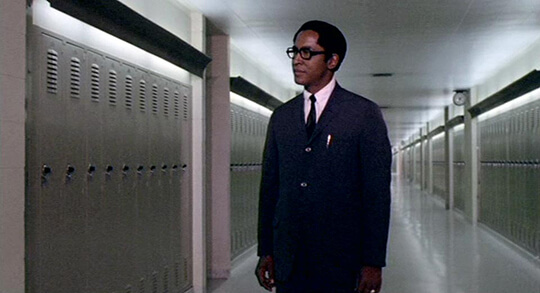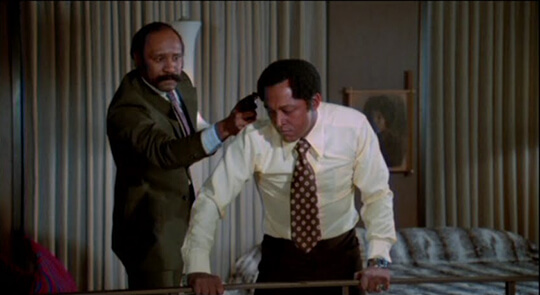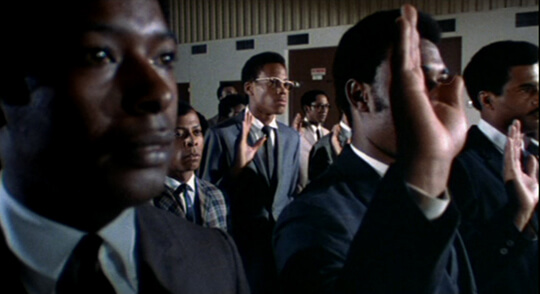
WHAT’S IT ABOUT
The Spook Who Sat by the Door stands as one of the most politically incendiary American films ever produced within the studio system. Directed by Ivan Dixon (best known as an actor from Hogan’s Heroes) and based on Sam Greenlee’s controversial 1969 novel, this militant film follows the journey of Dan Freeman (Lawrence Cook), the first Black CIA officer who uses his counterinsurgency training to organize a revolutionary Black liberation movement in Chicago.
The film opens with a cynical political calculation: a U.S. Senator facing reelection decides to criticize the CIA for its lack of diversity. In response, the agency launches a highly publicized recruitment drive targeting Black candidates, with no intention of actually integrating them into meaningful positions. Dan Freeman, a quietly determined social worker with a steel-trap mind, endures the thinly-veiled racism of the CIA training program and graduates at the top of his class—only to be appointed as the agency’s “top secret reproduction center section chief” (essentially a glorified copy clerk). Freeman recognizes his role as a token—the “spook who sits by the door,” referring both to the racial slur and to his position as a Black face displayed near the entrance to show visitors the agency’s supposed commitment to integration. For five years, he patiently learns everything he can about guerrilla warfare, weapons, sabotage, and intelligence operations while maintaining a deliberately unthreatening demeanor. When Freeman eventually resigns from the CIA and returns to Chicago, he leverages his background in social work to connect with street gangs. Using his CIA training, he transforms these gangs into disciplined “Freedom Fighters”—a revolutionary cell structure preparing for armed insurrection against the U.S. government. As the movement grows and violence escalates, Freeman remains several steps ahead of federal authorities who cannot imagine that the mounting chaos is being orchestrated by someone trained by their own government. The film’s unflinching portrayal of urban guerrilla warfare—including detailed instructions for making Molotov cocktails and staging strategic attacks—combined with its unapologetically revolutionary politics, made it a unique cultural artifact that both captured and helped shape Black radical thought in the post-Civil Rights era.



WHY IT’S GONE
According to director Ivan Dixon and author Sam Greenlee, the film was pulled from theaters within weeks of its release due to FBI pressure on the distributor, United Artists. While definitive documentation of this intervention remains elusive, the film’s disappearance aligns with known COINTELPRO operations targeting Black nationalist movements. The film’s radical politics—it explicitly portrays armed revolution against the U.S. government as a legitimate response to systemic racism—made it unwelcome in commercial cinemas. Even theaters in predominantly Black neighborhoods allegedly faced pressure not to screen it. The original negative was reportedly lost or destroyed, making proper restoration difficult for decades. The film survived primarily through a small number of prints preserved by collectors and activists. The film’s suppression may have contributed to the limited directing opportunities for Ivan Dixon afterward, despite his previous success as an actor. Even as interest in Black cinema grew in subsequent decades, the film’s explicit revolutionary content made it too controversial for mainstream revivals. The film was completely unavailable through legitimate channels for decades In the 1980s and 1990s, it circulated through underground networks via poor-quality VHS copies In 2004, actor Tim Reid discovered a surviving 35mm print in a vault and funded a restoration This restoration led to a DVD release through Monarch Home Video in 2004. The DVD quickly went out of print and became a collector’s item, often selling for $100+ on secondary markets. A second DVD release occurred in 2011 through IndiePix Films, which also eventually went out of print. As of 2025, the film has not received a Blu-ray release or HD restoration. It remains absent from all major streaming platforms, including Netflix, Amazon Prime, Hulu, and HBO Max. The film occasionally appears on specialized streaming services like the Criterion Channel or Mubi for limited periods. Officially launched on April 7, 2021, Cultpix is a global streaming service for classic genre and vintage cult films and television shows. If they don’t have it, most viewers still encounter the film through unauthorized uploads or university/museum screenings. Despite (or perhaps because of) its suppression, The Spook Who Sat by the Door has maintained a powerful underground reputation. It’s frequently cited as an inspiration by Black filmmakers, including Spike Lee. Academic studies of Black cinema treat it as a crucial missing link in understanding the evolution of Black political representation on screen. The film serves as a time capsule of post-Civil Rights era Black revolutionary thought. Its technical achievements—a professionally executed action film with sophisticated political content made on a limited budget—remain impressive. It demonstrates how institutional forces can effectively erase culturally significant works from public memory. The continued difficulty in accessing The Spook Who Sat by the Door represents not just a gap in film history but a concrete example of how political suppression can function within cultural industries. While the film’s revolutionary politics remain controversial, its virtual disappearance from distribution channels raises important questions about who controls which stories are preserved and circulated, and how certain radical perspectives can be marginalized not through explicit censorship but through the quieter mechanisms of distribution and preservation.

